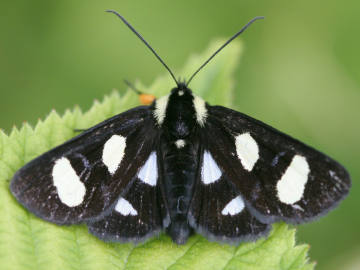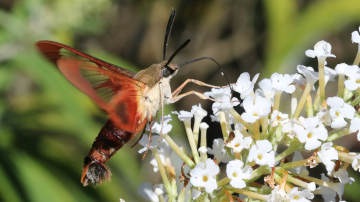Nature Notes

PHOTO COURTESY OF GARRY KESSLER
Day-flying eight-spotted forester moth.
July 25, 2023
NATURE NOTES
By Annie Reid
Westborough Community Land Trust
Noticing local day-flying moths
When something colorful flutters in a garden or long grass, do you think “butterfly”? Or perhaps “moth”? Or maybe even “day-flying moth”? The eight-spotted forester moth is a day-flying moth that you might spot in late spring and summer. Others include the unusual-looking hummingbird clearwing moth and snowberry clearwing moth. Both hover at flowers and have mostly-transparent wings.
The eight-spotted forester (Alypia octomaculata) is small but striking. With a wingspan of 1 to 1-1/2 inches, it’s black with eight large white or light-yellow spots on its wings. It has fuzzy orange hairs on its front and middle legs. It’s in the owlet moth family (Noctuidae).

PHOTO COURTESY OF GARRY KESSLER
Day-flying eight-spotted forester moth
Keep your eye out for the eight-spotted forester around Virginia creeper (Parthenocissus quinquefolia), a vine that might be growing in your yard (see past Nature Notes westboroughlandtrust.org/nn/nn176). Also look near wild grapevines (Vitis) along trails and woodland edges. These vines are host plants for this moth, which means the moth lays eggs on them. Then moth caterpillars hatch, feed on the foliage, and eventually make cocoons nearby to overwinter until spring.
Like butterflies and other day-flying moths, the eight-spotted forester seeks nectar from flowers, pollinating them in the process. This moth sometimes comes to lights at night, like other moths, but not commonly.
How can you tell a day-flying moth from a butterfly? One clue is the tip of its antennae, if you can get a good look. Butterflies have knobs (or hooked knobs) at the ends of their antennae, but moths have feathery, fern-like, or plain antennae. The eight-spotted forester has plain antennae that are slightly thickened and slightly bent at the end.

PHOTO COURTESY OF GARRY KESSLER
Day-flying hummingbird clearwing moth
Hovering at flowers, the hummingbird clearwing moth (Hemaris thysbe, westboroughlandtrust.org/nn/nn58) can be easy to mistake for a hummingbird or a giant bumblebee. The same goes for the snowberry clearwing moth (Hemaris diffinis), which looks quite similar, but has black legs, rather than pale legs. Common host plants for their caterpillars include honeysuckle for both, viburnum for the hummingbird clearwing, and snowberry for the snowberry clearwing. Both moths are in the sphinx moth family, which has mostly night-flying moths.
Until quite recently, researchers thought that butterflies had probably evolved from day-flying moths due to bats. The idea was that moths that flew during the day prospered because they had the survival advantage of avoiding bats, which fly at night and feast on moths. But now, new research shows that butterflies existed long before bats were able to fly. A different explanation for the origin of butterflies was needed.

PHOTO COURTESY OF GARRY KESSLER
Day-flying snowberry clearwing moth
New information came from a massive research study, involving DNA comparisons, range maps, 1900 butterfly species on a new family tree for butterflies, and 11 butterfly fossils. The study indicated that about 100 million years ago, ancestors of today’s butterflies originated from night-flying ancestors of today’s moths. This likely took place in Central America and western North America. The time was long before dinosaurs went extinct (66 million years ago). Later on, only 52 million years ago, the ancestors of today’s bats developed the ability to fly.
What enabled ancestors of today’s butterflies to prosper, diversify, and spread around the world? In short, their big advantage has been their association with flowering plants, which bloom and make nutritious nectar mostly during the day. (Flowering plants originated about 145 million years ago.) As caterpillars, most butterfly species today feed on plants in the bean (legume) family and the grass family (yes, grasses are flowering plants). But as adults, most butterfly species take nectar from flowers, pollinating them in the process (as do bees, birds, some moths, and various other insects).
Interested in more than this brief peek into butterflies’ past? Check out this reader-friendly article (earth.com/news/mystery-solved-when-butterflies-evolved-and-what-plants-they-used-for-food). For the massive study, see (nature.com/articles/s41559-023-02041-9).
How can people help butterflies and day-flying moths these days? We can protect and care for butterfly habitats, reduce the use of pesticides, and plant butterfly-friendly plants.